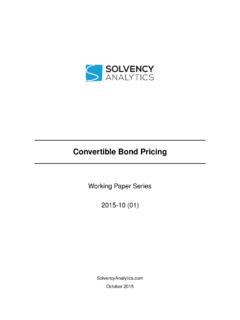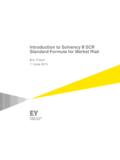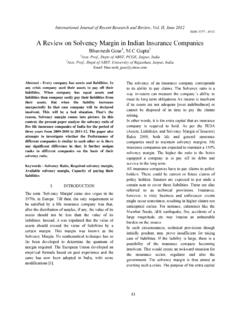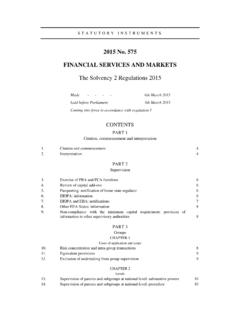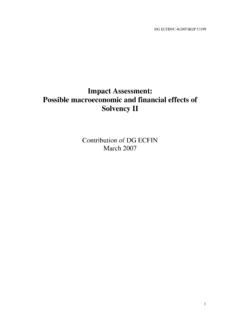Transcription of Convertible Bond Pricing - Solutions under …
1 Convertible bond PricingWorking Paper Series2015-10 (01) 2015 Convertible bond PricingBal azs Mez 2015 Convertible bond investments may have a special role under solvency II and the SwissSolvency Test as they are favoured over equities due to their convex payoff profile. Es-pecially under solvency II, replacing equities by an optimized Convertible bond portfoliocan reduce the solvency capital requirement (SCR) significantly while keeping risk/return char-acteristics virtually unchanged. Therefore, we believe that for small and mid size insurancecompanies where constraints on investment volume are less relevant, solvency II optimizedconvertible bond strategies will be an attractive alternative to formulating such investment strategies Convertible bond Pricing functions have to becorrectly implemented and tested.
2 As convertibles are sensitive to a variety of market risk fac-tors defined under solvency II s standard model ( interest rate, spread, equity, currency)and exhibit various optional features, a thorough understanding of different Convertible pricingfunctions is needed. The aim of this paper is to consider the practical and theoretical aspectsof Convertible bond Pricing , and create a Pricing model using relevant Convertible bond featuresand risk factors. This paper is relevant as one step in the process of structuring a solvency IIoptimized portfolio (which will be treated in separate publications) as investors and regulatorsare likely to require a properly tested asset Pricing bonds are not at all a new investment innovation; the first Convertible bonds were is-sued by US railroad companies in the 19thcentury.
3 Nowadays global Convertible bond marketsoffer a broad country and sector diversification with roughly 50% US, 30% Europe and 20%Asia (and a few but quite interesting issues from other regions) with all major sectors being rep-resented. In the exceptionally low interest rate environment this asset class s popularity hasincreased also among fixed income investors searching for return opportunities. Apart from theequity-like return potential that global CB markets have demonstrated, convertibles have theadvantage of typically performing positively if interest rates rise and therefore often work wellfor hedging duration risk. But also compared to equities, convertibles can be attractive: theirdownside risk is lower due to the bond floor s protective nature.
4 While historically convertiblebonds have even outperformed equities and this at a volatility which is two third of equities,they are of course not a free lunch. As convertibles are typically less liquid than equities with aliquid CB market volume at roughly 250bn USD, they are likely to be an investment opportunityto small to mid size institutional investors rather than their larger the technical perspective, Convertible bonds (CBs) are corporate bonds with an embed-ded option to be converted into a predefined number of shares. Consequently, convertiblebonds have equity-like and bond -like characteristics. They are priced similarly as corporatebonds if the equity price is low. If the equity s price is high, a Convertible bond is likely 2 of 34be converted and the price behaviour is similar to the underlying share.
5 Due to the dynamicchange of their risk profile (between debt and equity) CBs are often calledhybridsand some-times referred to as a separate asset of the major challenges of Convertible bonds is to find an efficient Pricing method thatis consistent with observed market prices. This paper evaluates various Pricing models forconvertible bonds and shows the implementation of three different modifications of a binomialtree-based Pricing model using real world CB are several questions that need to be addressed when specifying a Convertible bond pric-ing , most often observed Convertible bond features need to be categorized as theyhave to be considered as input to the Pricing function. Plain-vanilla Convertible bonds can beconverted into a predetermined number of shares if certain conditions are met.
6 However, thereare many other possible features which are used by many issuers, such as callability, putabil-ity, contingent conversion or soft callability and have to be treated explicitly by Pricing , Pricing models need to include all relevant risk factors of Convertible bonds. Thereare several considerations due to their hybrid characteristics: the price of a Convertible bonddepends on the underlying share s risk factors and also on the risk factors of the bond are several options discussed in the literature such as constant or stochastic volatilityand constant, deterministic or stochastic interest , after the selection of the risk factors, one needs to select the appropriate model are several models in the literature including binomial tree models, trinomial tree mod-els, Monte Carlo methods and analytical Solutions .
7 There are several questions about theimplementation too, for example computational speed which may become crucial for 1 discusses the most important characteristics and definitions regarding convertiblebonds and aims to provide the relevant foundations of this asset class. Chapter 2 introducesthe relevant literature of the Pricing models and describes a binomial-tree based Pricing modeland its extension using different implementations of credit risk. The first version of the modeluses constant credit spread, the second version discusses a so-called credit-adjusted discountrate (Goldman Sachs (1994)) and the last extension of the model uses a default intensity-basedcredit model. Finally, Chapter 3 investigates the convergence of the model and conducts sen-sitivity 3 of 34 Contents1 Introduction to the Pricing of Convertible Definition of Convertible Bonds.
8 Basic Terminology of Convertible Bonds .. Convertible bond Features .. Exit Scenarios of Convertible Bonds ..82 The Pricing Review of Literature .. The Building Blocks of the Pricing Model .. Stock Price Process .. Convertible bond Valuation Tree .. Extension of the Model Using Exotic Features .. Extension of the Model Using Credit-Adjusted Discount Rate .. Extension of the Model Using a Reduced Form Credit Risk Model ..183 Convergence and Sensitivity Analysis of the Pricing Convergence of the Binomial Model .. Sensitivity Analysis of the Pricing Model ..24 Conclusion29 Glossary of 4 of 341 Introduction to the Pricing of Convertible BondsThis chapter introduces the key characteristics of Convertible bonds (CBs).
9 While a varietyof notations can be found in the literature, the one introduced in the following chapter will bepursued and used throughout this Definition of Convertible BondsConvertible bonds are typically referred to as hybrid securities as they combine the charac-teristics of debt and (2000) defines a Convertible bond as a corporate bond that can be converted into a prede-termined amount of the company s share at certain times during its life. This definition suggeststhat Convertible bonds are derivative securities whose value is derived from the value of theunderlying equity and the underlying to Goldman Sachs (1994) European-style Convertible bonds can be decomposed inthe following two ways:1. Fixed income point of view: a straight bond plus a call option that allows the investor to exchange the bond Equity point of view: an equity plus a put to exchange the equity for a straight bond ; and a swap to maturity that gives the investor the bond s coupons in exchange for theequity s two ways are useful to understand the basic structure of a European-style convertiblebond from an equity and a bond investor s point of view.
10 However, in real life most convert-ible bonds are American-style that can be exercised at any time during the life of the productand they often exhibit additional features such as contingent conversion, putability and calla-bility, which need to be included in the Pricing model. These features clearly complicate thedecomposition into simpler Basic Terminology of Convertible BondsThis section introduces the most important concepts of Convertible bonds with the content andnotation based on Spiegeleer and Schoutens (2011).Without the conversion option a Convertible bond has the same specifications as a corporatebond, therefore it has a maturity date, a face value, redemption and a coupon which are de-fined as:Maturity Date (T):Date on which the Convertible bond Value (N):The notional amount of a Convertible (R):The amount paid out to the investor at the maturity date if the CB has notbeen converted prior to maturity.
